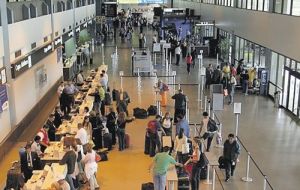MercoPress. South Atlantic News Agency
International tourists arrivals up 7% in half year; Asia and Middle East lead
 In the Americas Central and South America have been the most dynamic
In the Americas Central and South America have been the most dynamic The first six months of 2010 saw international tourist arrivals grow by 7% according to the August Interim Update of the UNWTO World Tourism Barometer. This result confirms the recovery trend beginning in the last quarter of 2009 and is expected to continue in the second half of the year at a somewhat more moderate rate but with Asia and Middle East continuing to lead.
The Interim Update was officially presented at the 4th UNWTO/PATA Forum on Tourism Trends and Outlook (2-4 September, Guilin, China) to tourism stakeholders from the public and private sector, as well as academia.
International tourist arrivals in Asia and Middle East are estimated to have grown by 7% in the first half of 2010. While growth was modest in April as a consequence of the closure of European airspace following the eruption of a volcano in Iceland, results were strong in May (+10%) and June (+8%). Data available for July indicates that growth is set to continue at a steady rate.
Growth was positive in all world regions, led by a robust performance of emerging economies expanding at 8% compared to 6% in advanced economies. Asia and the Pacific (+14%) and the Middle East (+20%), where results were already positive in the second half of 2009, continue to lead growth in the first half of 2010 with the majority of destinations in both regions posting double digit growth rates.
International tourism has been a driving force in the region - currently the second most visited region in the world,- with 181 million international tourist arrivals (21% of world total) and international tourism receipts of US$ 204 billion (24% of world total) in 2009.
In the Americas (+7%), Central and South America show steady growth, as does North America. Growth has been slower in the Caribbean but results are still markedly improved as compared to 2008 and 2009.
Europe (+2%) shows the slowest recovery but results from recent months are slightly more positive. Although recovery has not yet returned to Northern Europe, both Western and Southern Mediterranean Europe show reasonable growth.
Africa (+7%), the only region to grow in 2009, maintained this momentum during the first half of 2010.
International tourism receipts are expected to lag somewhat behind arrivals in many destinations. Following major shocks, volume (arrivals) tends to recover faster than income (receipts) as travellers travel closer to home, for shorter periods of time and seek value for money, while on the supply side increased competition has been driving prices down. This was also the case following the Asian economic and financial crisis and after the 2001 September 11 terrorist attacks.
Overall, international tourist arrivals totalled 421 million during the first six months of 2010, up 7% on 2009, but still 2% below that of the record year of 2008 (428 million arrivals in the same period). These results follow one of the toughest years for the tourism sector with international tourist arrivals declining by 4.2% in 2009 to 880 million and international tourism receipts reaching US$ 852 billion (€611 billion), a decrease in real terms of 5.7%. The return of growth must be thus viewed with caution given that it compares with a very weak period of 2009.
Nevertheless, many destinations are setting new records, leaving behind the losses of 2009 and exceeding the 2008 levels. Compared to the first half of 2008, six sub-regions show growth: Sub-Saharan Africa (+16%), North Africa (+12%), North-East Asia (+7%), South Asia (+7%), South-East Asia (+5%) and South America (+4%).
For 2010, UNWTO maintains its initial forecast of international tourist arrivals growing by 3% to 4%. Current growth rates, coupled with an improving global economic environment suggest that end-year results are likely to be closer to 4%, and may even exceed this figure.
However, high unemployment continues to be a major cause of concern and the austerity measures as well as the rise in taxation implemented in several advanced economies to fight public deficits represent a clear challenge to many leading outbound markets.
“Although we are witnessing a clear recovery in international tourism, we must remain cautious,” said UNWTO Secretary-General, Taleb Rifai in Madrid. “In many advanced economies, namely in the USA and in some major European markets, economic recovery has still to consolidate. To this we must add the recent introduction and increase in taxation, most specifically those which directly impact the tourism sector, such as air transport taxes. While we fully understand the need to balance public accounts, one-sided decisions on taxation risk adversely impacting a sector with a proven track record for job creation and economic growth, as one of the major generators of exports earnings and income sources for developing countries, which are crucial to a stable economic recovery.”




Top Comments
Disclaimer & comment rulesCommenting for this story is now closed.
If you have a Facebook account, become a fan and comment on our Facebook Page!